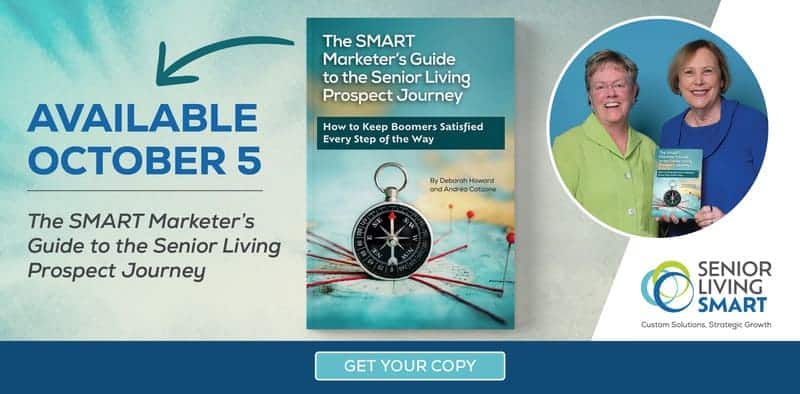Aspirational Marketing for Senior Living: Pitfalls to Avoid

Moving into senior living doesn’t have to be needs-driven only; it can also be desire-driven.
If you agree with this statement, you’ll likely be a fan of aspirational marketing, which involves positioning senior living as a desirable choice rather than a decision made out of crisis.
With aspirational marketing, the goal is to motivate potential residents to view moving into your community as a positive, forward-thinking decision while ensuring that all messaging remains authentic.
However, it’s this “authentic messaging” part that can cause even the best-intentioned marketers to stumble.
Below, we address this challenge by discussing the following:
- Why authenticity matters in aspirational marketing
- How to balance reality with aspirations
- Pitfalls to avoid with aspirational marketing
Why authenticity matters in aspirational marketing for senior living
No one likes a bait-and-switch. That’s the sort of thing that gives marketing a bad name.
For example, if your website promotes a “vibrant community” and the images show people in their sixties dancing in the pub, but the reality is the median age in your community is 81 and there’s no dance floor (or even a pub), well . . . you know how this movie ends, right?
People coming on tours are going to be super disappointed. You’ve wasted their time and your reps’ time. Not to mention, you’ve eroded trust.
On a recent podcast, Debbie Howard, SLS’s president and co-founder, discusses the challenges with aspirational marketing.
Debbie says, “I think most of our clients want to have younger, healthier, less acute residents who are going to stay longer and have a great experience. These clients will ask us to attract a younger, healthier, more aspirational resident who sees senior living as a choice, not a crisis. And yet, when this person comes for a tour, they don’t necessarily see a community filled with younger, healthier people.”
She adds that many clients often want to use stock images that feature younger seniors or represent more diversity, even if the community doesn’t have a diverse population.
“So it becomes a balancing act from a marketing perspective,” she says, “trying to attract that audience while also remaining authentic.”
How to balance reality with aspirations. (Hint: This isn’t just marketing’s burden.)
Doug DeMaio, SLS’s director of client success, says it’s imperative that the marketing team works with people from the community’s operational side to understand what’s truly real.
“We have to understand what initiatives they’re taking on the operational side so we can speak to their vision and mission and make sure that we’re speaking about things that are actually happening,” he explains. “They may be aspirational for the community at this point, and that’s OK, but real initiatives must be in the works.”
For example, let’s say you’re promoting that your community is an incredibly fun place to live. “Is it legitimately a fun place to be?” Doug asks. “Or are we just trying to pay lip service to it being a fun place to be?”
How a partnership between marketing and operations should work
To create an authentic aspirational marketing strategy, the marketing and operations teams must collaborate.
Doug highlights the importance of aligning the community’s actual offerings with the vision marketing promotes. This collaboration ensures the community is actively working toward the lifestyle it wants to portray.
“It’s not about sugarcoating, but about making sure that marketing is based on what’s actually happening or in the works,” he says.
Even if specific programs and initiatives don’t exist yet but plans for them are firmly in place, your marketing can promote them and provide timelines, launch dates, and the like.
For example, if your community is building a pub with a dance floor, you can highlight this information on the website and point out the construction during the tour.
Think of it like the colleges that constantly improve the grounds, dorms, and dining halls—it’s the same concept. People can appreciate the investment and the initiative (and that certain initiatives take longer than others) and envision what life will be like in the community once the initiative is fully launched or completed.
Doug adds, “It’s really about working with the community to balance the desire for aspirational marketing with the need for authenticity by ensuring operational changes back up the messaging.”
Through this collaboration, marketing can promote an aspirational future grounded in reality, creating a truthful and attractive narrative for potential residents.
Pitfalls communities should avoid when attempting aspirational marketing for senior living:
Over-promising and under-delivering: If the marketing portrays a vibrant, youthful community, but prospects see a different reality during a tour, it creates distrust.
Ignoring authenticity: Aspirational messaging should align with actual offerings. Misrepresenting the community’s services, diversity, or lifestyle can lead to disappointment.
Neglecting the current resident base: Focusing too much on attracting younger residents or the needs of your “future” demographic can alienate or undervalue the current resident population—and the prospects who would fit nicely within that population.
Over-reliance on stock photos: We’re not fans of stock images. Using real-life photography builds credibility and ensures there won’t be a disconnect when someone comes in for a tour.
Not collaborating with operations: Aspirational marketing should reflect genuine, ongoing efforts within the community. Without operational backing, marketing messages will fall flat.
Disregarding emotional drivers: Moving to senior living is an emotional decision. While marketing should be aspirational, it must also acknowledge prospects’ fears and concerns when considering senior living. (And yes, younger seniors also have legitimate fears and worries.)
Ignoring long-term prospects: While aspiring to attract younger, healthier residents might be essential to your community’s long-term goals, it’s equally important that your marketing still addresses the needs of those who may require higher levels of care in the future.
Do you need help striking the right balance with aspirational marketing for senior living?
Our content strategists can help you align your messaging with reality and future plans. Get in touch and let’s discuss your messaging needs.




